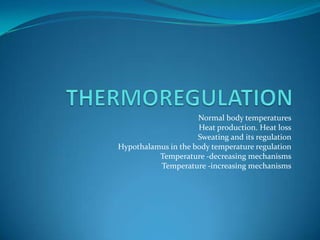
Thermoregulation
- 1. Normal body temperatures Heat production. Heat loss Sweating and its regulation Hypothalamus in the body temperature regulation Temperature -decreasing mechanisms Temperature -increasing mechanisms
- 2. Normal body temperatures In a healthy individual, the temperature of the core of the body is regulated by feedback control mechanisms that maintain it nearly constant around 98.6°F (37°C) throughout the day, week, month or year. This thermoregulation is efficiently coordinated by the central nervous system (CNS)
- 3. Heat production and Heat loss
- 4. Sweating and its regulation Sweating allows the body to regulate its temperature. Sweating is controlled from a center in the preoptic and anterior regions of the brain's hypothalamus,(thermosensitive neurons ). The heat-regulatory is also affected by inputs from receptors in the skin. High skin temperature reduces the hypothalamic set point for sweating and increases the gain of the hypothalamic feedback. However, the sweating response rised in hypothalamic ('core') temperature is much larger than the response to the same increase in average skin temperature. The process of sweating decreases core temperature, whereas the process of evaporation decreases surface temperature. two situations stimulate our sweat glands: during physical heat and emotional stress. Emotionally induced sweating is restricted to palms, soles, armpits, and sometimes the forehead, while physical heat- induced sweating occurs throughout the body.
- 5. Hypothalamus in the body temperature regulation hypothalamus (Thermostat Center) where there are neurons sensitive to changes in skin and blood temperatures. The temperature-regulating centers are found in the Preoptic Area (the anterior portion of the hypothalamus). This area receives input from Peripheral Thermoreceptors and Central Thermoreceptors The temperature sensory signals from preoptic area and those form the periphery are combined in the posterior.
- 8. Hot conditions.Temperature - decreasing mechanisms In hot conditions Eccrine sweat glands under the skin secrete sweat (a fluid containing mostly water with some dissolved ions). This causes heat loss via evaporative cooling; however, a lot of essential water is lost. The hairs on the skin lie flat, preventing heat from being trapped by the layer of still air between the hairs. This is caused by tiny muscles under the surface of the skin called Arrector pili muscles relaxing so that their attached hair follicles are not erect. These flat hairs increase the flow of air next to the skin increasing heat loss by convection. When environmental temperature is above core body temperature, sweating is the only physiological way for humans to lose heat. Arterioles Vasodilation occurs, this is the process of relaxation of smooth muscle in arteriole walls allowing increased blood flow through the artery. This redirects blood into the superficial capillaries in the skin increasing heat loss by convection and conduction.
- 9. Cold conditions. Temperature - increasing mechanisms Sweat stops being produced. The minute muscles under the surface of the skin called erector pili muscles (attached to an individual hair follicle) contract (piloerection), lifting the hair follicle upright. This makes the hairs stand on end which acts as an insulating layer, trapping heat Arterioles carrying blood to superficial capillaries under the surface of the skin can shrink (constrict), thereby rerouting blood away from the skin and towards the warmer core of the body. This prevents blood from losing heat to the surroundings and also prevents the core temperature dropping further. This process is called vasoconstriction. It is impossible to prevent all heat loss from the blood, only to reduce it. In extremely cold conditions excessive vasoconstriction leads to numbness and pale skin. Frostbite only occurs when water within the cells begins to freeze, this destroys the cell causing damage. Muscles can also receive messages from the thermo-regulatory center of the brain (the hypothalamus) to cause shivering. This increases heat production as respiration is an exothermic reaction in muscle cells. Shivering is more effective than exercise at producing heat because the animal remains still. This means that less heat is lost to the environment via convection. There are two types of shivering: low intensity and high intensity. During low intensity shivering animals shiver constantly at a low level for months during cold conditions. During high intensity shivering animals shiver violently for a relatively short time. Both processes consume energy although high intensity shivering uses glucose as a fuel source and low intensity tends to use fats. This is a primary reason why animals store up food in the winter. Mitochondria can convert fat directly into heat energy, increasing the temperature of all cells in the body. Brown fat is specialized for this purpose, and is abundant in newborns and animals that hibernate.
- 10. Fever. Chemicals called pyrogens released by white blood cells raise the set point of the thermoregulatory centre causing the whole body temperature to increase by 2-3 °C. This helps to kill bacteria, inhibits viruses, and explains why you shiver even though you are hot
